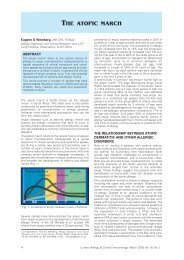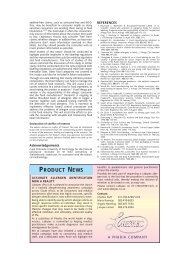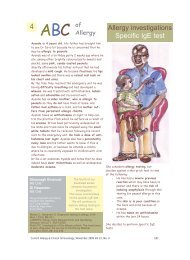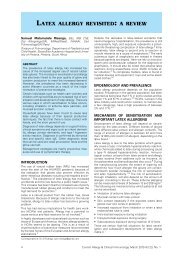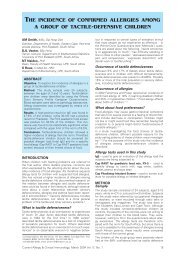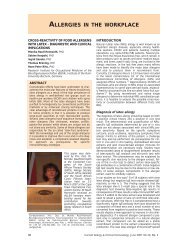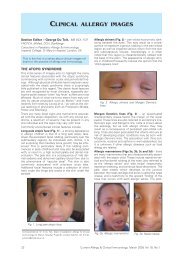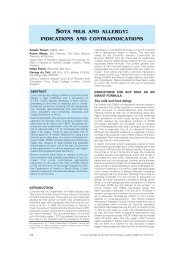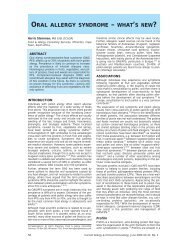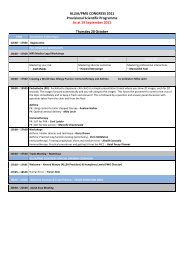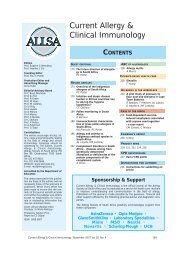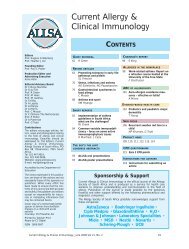Current Allergy and Clinical Immunology - March 2008
Current Allergy and Clinical Immunology - March 2008
Current Allergy and Clinical Immunology - March 2008
You also want an ePaper? Increase the reach of your titles
YUMPU automatically turns print PDFs into web optimized ePapers that Google loves.
INTRAVENOUS IMMUNOGLOBULINEA Goddard, MSc, MB ChB, PhD, MMed (Paed)School of Child <strong>and</strong> Adolescent Health, University ofCape Town <strong>and</strong> Red Cross Children's Hospital,Rondebosch, Cape Town, South AfricaABSTRACTThere has been a rapid expansion of the use of intravenousimmunoglobulin (IVIG) for an ever-growingnumber of conditions. IVIG is used at a ‘replacementdose’ (400-600 mg/kg/month) in antibody deficiencies.In contrast it is used at a high dose (2 g/kg/month) as an ‘immunomodulatory’ agent in anincreasing number of immune <strong>and</strong> inflammatory disorders.The limitations for IVIG are the cost of thepreparation <strong>and</strong> the need for intravenous infusions.Due to the cost, shortages <strong>and</strong> growing use of IVIGthere have been attempts to develop evidencebasedguidelines for the use of IVIG in a wide varietyof haematological, autoimmune <strong>and</strong> neurologicalconditions. This commentary provides the recommendations<strong>and</strong> recent publication regarding theuse of IVIG in various conditions. Although IVIG is asafe treatment option when compared with otherimmunosuppressive agents there needs to be anunderst<strong>and</strong>ing of the potential adverse reactions<strong>and</strong> their management. It is important for the physicianto carefully assess <strong>and</strong> monitor patients on IVIGso that treatment can be optimised.INTRODUCTIONIntravenous immunoglobulin (IVIG) replacement therapyhas greatly reduced the morbidity due to bacterialinfections associated with major forms of antibody deficiency.IVIG has a few proven indications <strong>and</strong> manypotential ones. There has been a rapid expansion in theuse of IVIG. It has had a major impact in the treatmentof conditions in the fields of neurology, haematology,rheumatology <strong>and</strong> dermatology. In a recent study inCanada the leading indications for IVIG use were idiopathicthrombocytopenic purpura (17.3%), primaryimmune deficiency conditions (14.9%) <strong>and</strong> chronicdemyelinating polyneuropathy (11.8%). The leadingprescribing specialists were neurologists (32.2%) <strong>and</strong>haematologists (26.1%). 1 It is safe <strong>and</strong> does not havethe side-effects of steroids or other immunosuppressiveagents.BACKGROUNDImmunoglobulin replacement has been st<strong>and</strong>ard therapyfor patients with primary immune deficiency diseasessince its use by Bruton in 1952. 2 For many years,these preparations could only be given intramuscularly.Administration of intramuscular immune serum globulinresulted in a decrease in the incidence of infectionsof patients with agammaglobulinaemia. However injectionswere painful, the IgG was absorbed slowly <strong>and</strong> itCorrespondence: Dr EA Goddard, Red Cross Children's Hospital,Klipfontein Rd, Rondebosch, 7701. Tel 021- 658-5111, fax 021-689-1287, e-mail liz.goddard@uct.ac.zawas difficult to maintain IgG levels above 2 g/l.Intravenous administration of immune serum globulincaused shock-like episodes, chills <strong>and</strong> hyperpyrexia.Although attempts were made to modify immuneserum globulin for intravenous use, intramuscular useremained the sole form of replacement therapy until1981 (29 years later) when intravenous preparationsbecame commercially available. This reduced the painof administration <strong>and</strong> allowed larger volumes to beinfused. Over 25 IVIG preparations are available worldwidewhich have been approved by various regulatorybodies. 3 All are tolerated <strong>and</strong> effective. The variousIVIG products differ in a number of ways includingimmunoglobulin <strong>and</strong> IgG subclass distribution, antibodycontent, approved maximum infusion rate <strong>and</strong> sideeffects.The characteristics of the various productsmay result in differences in efficacy <strong>and</strong> safety whichmay have a significant impact on the choice of productfor some patients.PRODUCTIONAn ideal IVIG preparation would contain structurally <strong>and</strong>functionally intact immunoglobulin molecules with anormal biological half-life <strong>and</strong> a normal proportion ofIgG subclasses. The preparation should contain highlevels of antibody or antibodies relevant to its proposeduse. There should be no contamination <strong>and</strong> vasomotorpeptides, endotoxin or infectious agents.Nearly all IVIG preparations are isolated from pooledhuman plasma (1 000 to 10 000 donors) by the Cohnalcohol fractionation method which results in five plasmafractions. The Cohn fraction II contains the bulk ofthe antibodies <strong>and</strong> is appropriate for intramuscular <strong>and</strong>subcutaneous use. This fraction is further purified forthe production of IVIG. The WHO has established thefollowing production criteria for IVIG (1982): 41. Each lot should be derived from plasma pooled fromat least 1 000 donors.2. It should contain at least 90% intact IgG with thesubclasses present in ratios similar to normal pooledplasma.3. IgG molecules should maintain biological activitysuch as complement fixation.4. It should be free from contaminants of prekallikreinactivator kinins, plasma proteases <strong>and</strong> preservatives.5. It should be free from infectious agents.As for all blood products donors are screened forhepatitis B surface antigen, HIV -p24 antigen, <strong>and</strong> antibodiesto syphilis, HIV-1, HIV-2 <strong>and</strong> hepatitis C.Commercial lots are produced from plasma pooledfrom 1 000 to 10 000 donors so contain a broad spectrumof antibodies. Differences in the manufacturingprocesses of different IVIG preparations affect opsonicactivity, Fc-receptor function <strong>and</strong> complement fixation.Thus different IVIG preparations should not be consideredas a generic productMECHANISM OF ACTION OF IVIGIVIG acts via a variety of mechanisms in different diseasestates <strong>and</strong> these have been reviewed in detail byBallow 5 <strong>and</strong> Jolles et al. 6 The mechanisms of action of26 <strong>Current</strong> <strong>Allergy</strong> & <strong>Clinical</strong> <strong>Immunology</strong>, <strong>March</strong> <strong>2008</strong> Vol 21, No. 1



